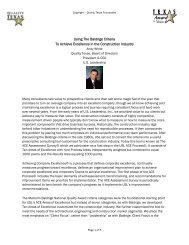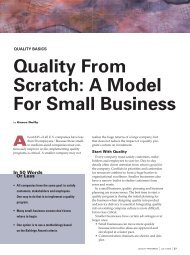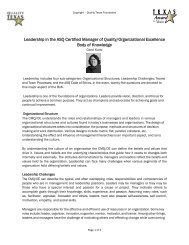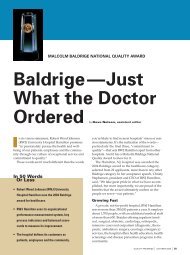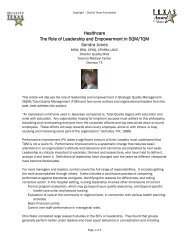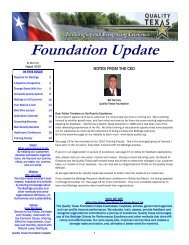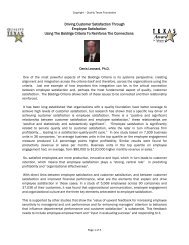Richland College - Quality Texas
Richland College - Quality Texas
Richland College - Quality Texas
- No tags were found...
Create successful ePaper yourself
Turn your PDF publications into a flip-book with our unique Google optimized e-Paper software.
MALCOLM BALDRIGE NATIONAL QUALITY AWARDA Community<strong>College</strong>’s Long-TermCommitmentby Susan E. Daniels, editor at largeAcommon lament among quality professionals isthat as soon as the leader who committed anorganization to quality leaves, so does thefocus on continual improvement.Certainly we can name companies that thrived undera top executive committed to quality only to see thatemphasis disappear—along with market success—under subsequent leaders.For example, under chief executive Jamie Houghton,quality was king at Corning from 1983 to 1996, and theIn 50 WordsOr Less• Ten years ago, after instituting various qualityapproaches, <strong>Richland</strong> <strong>College</strong> in Dallas was lookingfor sustained impact and began its Baldrige journey.• A president with more than 27 years in office and acommitment to quality performance was a key tothis community college’s 2005 Baldrige Award.QUALITY PROGRESS IJUNE 2006 I47
MALCOLM BALDRIGE NATIONAL QUALITY AWARDTABLE 1Organization<strong>Texas</strong> Instruments,City of Dallas<strong>Texas</strong> NameplateBank OneDisneycompany won a Baldrige Award in 1995. Houghton,a member of Corning’s founding family,retired. The bottom fell out of the telecommunicationssector, and Corning struggled both in themarketplace and stock market. Now Houghton hasreturned along with the emphasis on quality, andCorning seems to be coming back. 1The opposite is certainly true in the case of<strong>Richland</strong> <strong>College</strong> in Dallas, the first communitycollege to receive the Malcolm Baldrige National<strong>Quality</strong> Award.There, Steven K. Mittelstet, one of the school’s 27remaining 1972 founders, has nourished a cultureof high quality performance during his 27 years aspresident. That’s a term unheard of in the highereducation field, where the average president lastsless than seven years before leaving. 2“Mittelstet is the visionary force behind what<strong>Richland</strong> <strong>College</strong> is today,” says Kay Eggleston,vice president for institutional effectiveness. “Hisleadership provides a consistency and unwaveringcommitment to quality performance from seniorstaff. He hires competent people and developsStarbucks experiencemusic projectSouthwest Airlines,Container StoreBranch-Smith PrintingPresbyterian Hospitalof DallasMedrad Inc.Saint Luke’s Hospitalof Kansas CityRobert Wood JohnsonUniversity HospitalOutside Higher Education BenchmarksNature of benchmark activitySustainable architectural designElectronic dashboard, senior leader performanceevaluationCustomer service “front counter”approachesEmployee interview/screening,new employee orientationExperience engineering for Thunderduck Hall andnew buildingsEmployee cultureSupplier/partner scorecardEmployee professional developmentDiversity in managementEmployee retention/turnover/satisfactionEmployee retention/turnoverFIGURE 1IntegrationDisseminateresults.7LearningEvaluatetheprocess.8Measureimpact.6Process ImplementationAnd Improvement PlanDeploymentIdentifyimprovementneed.1EvaluationandimprovementapproachImplement/pilotapproach.5Assignownership.2Developsolution.4Identifyrootcause.3Approachtheir talents and abilities, as evidenced by the 22former <strong>Richland</strong> employees who have gone on tobecome college presidents elsewhere.”One of seven two-year community colleges inthe Dallas County Community <strong>College</strong> District,<strong>Richland</strong> enrolls about 14,500 for-credit and almost6,000 continuing education students each semester.It serves an area with not only a rapidly growingpopulation typical of large Sunbelt cities but alsochanging demographics, including an influx ofthose for whom English is not a first language.<strong>Richland</strong>’s key student segment is one whoseprimary goal is eventual transfer to a four-yearuniversity, but its student body ranges from adolescentsin its math, science and engineering programfor high school students to senior citizenstaking continuing education courses.<strong>Richland</strong>’s mascot is R. Mobius Thunderduck(“Moby Duck”). The Thunderduck culture reflects<strong>Richland</strong>’s agrarian beginnings and permeates studentand employee life, supporting the creation oflifelong learners, community builders and globalcitizens.Meeting Challenges<strong>Richland</strong> addresses challenges directly throughits strategic planning approach. In addition to populationdemographic changes, the strategic challengesinclude:48 IJUNE 2006 Iwww.asq.org
BALDRIGE CEREMONY: Stephen K. Mittelstet,<strong>Richland</strong> <strong>College</strong> president, and Kathryn Eggleston,vice president for institutional effectiveness andeconomic development, receive the Malcolm BaldrigeNational <strong>Quality</strong> Award from Vice President DickCheney at an April ceremony in Washington, DC.•Technology jobs decreasing in the employerbase, with students shifting to courses thatwill transfer to four-year colleges.• Less prepared students and fewer resources inK-12 institutions. 3• Increasing faculty and leadership retirements.•A need to minimize disruptions as facilitiesare built to expand capacity.•A need to closing enrollment and student successgaps, particularly for Latino populationsand students.<strong>Richland</strong>’s use of benchmarking has been somewhatunique. While the activity includes examiningresults from surveys of students and employees andcomparative data from other schools, it also looksclosely at financial comparative performance ratingsand data from a pretty impressive group of for-profitsthat includes previous Baldrige recipients (seeTable 1).Strategic and operational deployment of its plando-study-actcycle—refined to what it calls anapproach-deployment-learning-integration cycle—is embedded in <strong>Richland</strong>’s process implementationand improvement plan (see Figure 1).Organizational learning is also embedded in<strong>Richland</strong>’s culture, consistent with its passion forcontinuous learning and knowledge asset sharing.Enter the Baldrige CriteriaWhile those associated with <strong>Richland</strong> knew it wasa quality organization, it didn’t have a systemic,comprehensive way to demonstrate it until about 10years ago when it began its Baldrige journey. Priorto that, staff had worked with total quality managementand management by objective, but these andother approaches didn’t seem to have a sustainedimpact on <strong>Richland</strong>’s organizational performance,according to Eggleston.“Metrics to demonstrate our achievements werenot clearly defined and systematically tracked withclear targets and action plans,” she explains.<strong>Richland</strong> leadership knew that, as a nonprofit,the school had to become more efficient, effectivePhoto by Arnie Sachs, Consolidated News Photosand entrepreneurial. External support at the statelevel was consistently decreasing—from 70% threelegislative sessions ago to the current 30%.To reach its goal of excellence, leadership decidedit needed to adopt the seven Baldrige categoriesof criteria:1. Leadership.2. Strategic planning.3. Student, stakeholder and market focus.4. Information and analysis.5. Faculty and staff focus.6. Process management.7. Organizational performance results.LeadershipWhile the president’s and founders’ many yearsof service have been important, <strong>Richland</strong>’s entiresenior leadership team (called the ThunderTeam)and philosophy of empowering employees haveplayed a key role in <strong>Richland</strong>’s Baldrige award.Employee empowerment deploys the Carver principleof “freeing those closest to the work to makeresponsible decisions.” 4 This allows employees toanalyze information, determine course correctionsand quickly respond to change in the environmentthrough formal and informal decision making.The president’s cabinet consists of the ThunderTeamplus the president’s direct reports, key deans anddirectors from vice presidential councils, and presidentsof the student government and professionalstaff support associations and faculty council.The cabinet formally reviews how effectivelywritten policies and procedures provide balancedfreedom and parameters to employees, sharpeningorganizational and employee clarity and minimizingredundancy.QUALITY PROGRESS IJUNE 2006 I 49
MALCOLM BALDRIGE NATIONAL QUALITY AWARDIn 1998, to address impacts on society, the communityand economic development council replaced randomefforts with systematic environmentalscanning that includes focus groups. This allowsthe ThunderTeam to keep abreast of public concernsof stakeholders, including those from the private sector,such as chambers of commerce.Areas of concern led <strong>Richland</strong> leadership to focussupport efforts on two key communities: underpreparedstudents, particularly Hispanic and otherEnglish language deficient groups, and communitieschallenged in the areas of transportation andsustainable public spaces and facilities.Strategic Planning<strong>Richland</strong>’s strategic and operational planningprocess and timing are depicted in Figure 2. Itshows a seamless connection between the innerorganizational work of monitoring progress inmonthly reviews and the outward achievement ofstrategic planning milestones.Strategic planning is an institutionwide behaviorusing priorities and key performance indicators(KPIs) to guide action planning at all levels.<strong>Richland</strong>’s Baldrige application says a keystrength is its gathering and use of informationfrom students, stakeholders and internal andexternal scans to identify strengths, weaknesses,opportunities and threats.Key inputs into strategic planning are factorssuch as educational reform, student and stakeholderneeds, student and community demographics,competitive and market environments, technologyand innovation, HR needs, and financial and otherrisks and economic changes.Organizational, departmental and individualaction plans and quality enhancement plans cascadefrom the strategic planning priorities, organi-FIGURE 2Strategic and Operational Planning ProcessStart hereAugust• Update five-year strategic plan and one-year operational working plan.• Formalize quality enhancement plan (QEP) focus for coming year.June and July• Board of trustees budget work session.• Staff progress discussions.September• Board of trustees formally adopts budget.• Finalize key performance indicators (KPIs), measures and targets.• Publish and implement updated strategic and one-year operational working plans.• Align individual and departmental plans to updates.• Deploy QEP focus.May• Finalize and submit operationalplan and budget request fornext cycle.April• Begin operational and budgetOctober and Novemberplanning for next cycle.• End-of-year results received and analyzed.• Operational plan modified based on end-of-year results.February and March• Mid-year review.Note: Circles denotemonthly KPI/QEP reviews.December• Publish official, updatedone-year operational planand end of year report.January• <strong>College</strong>/departmental/individuals updateplans based on official operational plan.50 IJUNE 2006 Iwww.asq.org
GRADUATION DAY: <strong>Richland</strong> <strong>College</strong> grads frequently move on to four-year universities.zational objectives and KPIs and measuresthroughout the entire workforce to ensure collegewidealignment.Student, StakeholderAnd Market Focus<strong>Richland</strong>’s focus on students, stakeholders andthe market has led to new activities and impressiveresults. For example:• The number of students who completed thecore curriculum in preparation for transfer tofour-year institutions grew from 500 in 2002 to1,660 in 2005.• Senior leaders have worked with outside professionalsand community groups to identifyand resolve public concerns and with manyagencies to support underserved and homelessstudents through adult literacy programs andgeneral equivalency diploma, or GED, training.• A variety of approaches, such as satisfactionsurveys, student involvement on councils andadvisory committees, and meetings with highschool partners, balance the needs of studentsand other stakeholders.• Consistent improvements in measures of studentsuccess are evident in the overall percentageearning a grade average of C or betterand corresponding increases in student performancefollowing transfer to four-year collegesand to technical fields.Eggleston says <strong>Richland</strong> set its KPI targets forthis student learning outcomes performance measureat a level that discourages grade inflation.“This is an example of how we are data informed,not data driven,” she explains.“We engage faculty within teaching disciplinesand departments to discuss this important issuebecause we are seeking student learning successfor life, not merely success numbers on a chart,”Eggleston adds.Measurement, Analysis andKnowledge ManagementWhile <strong>Richland</strong> formally evaluates its KPIs eachAugust, they are actually evaluated monthly toallow response to unexpected and rapid changes.If an issue is chronically static, a program seems tohave stagnated or a major external challenge occurs,the ThunderTeam commissions breakthrough orinnovative approaches—usually with cross functionalteams and sometimes with external partners orstakeholders—to help players get out of the box.Recent breakthrough and innovative approachesinclude:•A pilot model for stakeholder accreditationsignificantly influenced by Southern Assn. of<strong>College</strong>s and Schools accreditation standards.• <strong>Richland</strong>’s Collegiate High School of Mathematics,Science and Engineering’s breakthroughapproach to offering more dualcredits for high school and college accommodatesan increasing number of area homeschoolers and others. <strong>Richland</strong> believes this isthe first program in <strong>Texas</strong> and perhaps eventhe nation to offer only dual credit.•A self-paced developmental math option hasbeen a multiyear phase-in innovation.• Multilevel instructional teams of lead faculty,teaching administrators and professional supportstaff has been a breakthrough approachin the classroom.This ability to make rapid changes is also evidentin the IT area. For example, the college reserves partof the budget allocation for technology expendituresQUALITY PROGRESS IJUNE 2006 I 51
MALCOLM BALDRIGE NATIONAL QUALITY AWARDFIGURE 3Academic Credit Course Design ProcessSourcesStrategic planning.Enrollment demand.Academic course guidematerials (ACGM) opportunities.Business requests for skills.Professional accreditation.Organization’s websites.Relationships with four-yearuniversities.Curriculum committees.Advisory committees.State requirements.Assessfeasibilityanddesirability.Research(ACGM,uniqueneed,sequence).ApprovalDesign courseoutcomes,modeobjectives,materials andevaluation.Develop syllabususing outline,calendar, policies,information,methods andsequence.Implementandevaluate.to allow adjustments if enrollment changes.Opportunities for improvement are considered inthe annual budget cycle.<strong>Richland</strong>’s primary method of collecting andtransferring knowledge among faculty and staff isthrough workgroup meetings, process documentationand the quality enhancement plan process, inwhich all full-time employees participate each year.Faculty and Staff FocusBecause of summer gaps in its work systems forteaching, <strong>Richland</strong> designed an innovative approachto supplement the traditional balance of faculty andadjunct faculty by creating new 12-month, full-timepositions called instructional specialists and administratorswho teach.Instructional specialists teach in areas in whichstudents need extensive personalized services,such as English as a second language and developmentalmath.Faculty, who are hired on nine-month teachingcontracts, are not available in the summer, so theadministrators who teach must balance teachingand functions such as budgeting, managing facultyschedules, recruiting students and designing andimproving programs.The success of this innovation led the DallasCounty Community <strong>College</strong> District to offer 10-,11- and 12-month faculty contracts starting in 2005.While <strong>Richland</strong> employee turnover is somewhathigher than that of its peer colleges, this is not anindication of any sort of employee dissatisfaction—remember those 27 founders who are still at theschool and the 22 others who have gone on to bepresidents of other colleges.<strong>Richland</strong>’s Baldrige application points out thatall four staff who left after 15 years of serviceretired. The highest turnover is in professional supportstaff positions, in which many left after receivingassociate’s degrees, enabling them to progressbeyond entry level positions.Process ManagementOf course, the bulk of <strong>Richland</strong>’s process orientedculture focuses on learning centered processes.Key requirements are identified through listeningto and learning from students and each stakeholdergroup.Figure 3 shows how <strong>Richland</strong> determines whena new course is needed. The design and developmentprocess for new academic courses identifieskey student requirements early and incorporatesthem into the design.<strong>Richland</strong> uses a similar process to develop programsfor major workforce education and noncreditcontinuing education programs. For smallercontinuing education programs, an abbreviatedapproval process enhances agility in design andreduced cycle time to delivery.Both qualitative and quantitative measures andassigned in-process formative and end-processsummary measures are key performance measuresfor learning centered processes. Figure 1 (p.48) represents the approach used throughout the52 IJUNE 2006 Iwww.asq.org
RICHLAND’S PRESIDENT: Stephen K. Mittelstet hasbeen with the school for more than 27 years.college to improve student learning, student servicesand support processes.<strong>Richland</strong> has learned to minimize the costs ofinspections, tests and audits through economies ofscale derived from the Dallas County Community<strong>College</strong> District.Organizational Performance ResultsCategory seven of <strong>Richland</strong>’s Baldrige applicationincludes 16 pages of performance results, coveringeverything from student learning, studentand stakeholder focus, fiduciary responsibility andefficient use of resources, faculty and staff, organizationaleffectiveness, and leadership and socialresponsibility.Of interest to taxpayers, Figure 4 is a cost analysisof <strong>Richland</strong>’s use of budget resources. The collegehas decreased its cost to budget while improvingservices, adding employees and implementinginnovative approaches. The percentage of budgetfor instruction is monitored to maintain focus onstudent learning.Other result highlights not mentioned earlierinclude outperformance of peers and continualimprovement in actual performance of transferstudents, tuition rates the lowest of all communitycolleges in <strong>Texas</strong>, a high level of diversity in managementand high scores for employee expectationsand satisfaction.Lessons LearnedEggleston shared six lessons learned from<strong>Richland</strong>’s 10-year plus Baldrige journey:1. There are no quick fixes. While the criteriamay seem daunting at first, leadership foundthe more they used the criteria, the more thecriteria became part of the institutional languageand practice.2. Leadership propels and sustains the process.The commitment of the senior leadershipteam is crucial, not only to launch the qualityjourney but, more importantly, to sustainquality efforts.3. The whole person culture is important. Aculture that encourages employees to be intellectuallyand emotionally authentic wholepersons creates a safe place for people to takeresponsible risks and engage their wholeselves in learning and work that matters.This is an environment in which creativity andstudent learning success can flourish.4. Focus on the student/customer. The Baldrigecriteria helped them better listen and learnfrom students and other key stakeholders and,in turn, anticipate, meet and exceed expectations.In a constantly changing external environment,the needs of students and thecommunity served change rapidly. Baldrigeprovides a framework to be more agile.5. Employees are the key to making it happen.Senior leaders must set the direction, communicate,develop, recognize and reward employeesito ensure success.FIGURE 4Percentage budget spent100806040200< 75%GoodBudget Performance> 45%Payroll Instruction99/00 00/01 01/0202/03 03/04 04/05Photo by Elizabeth Lavin, Dallas CEO magazineGood< 99.5%GoodPercentageof totalGoals =Source: Dallas County Community <strong>College</strong> District colleague system.QUALITY PROGRESS IJUNE 2006 I 53
MALCOLM BALDRIGE NATIONAL QUALITY AWARD6. Learn from others. Breakthroughs and innovationsare often based on benchmarking. Thecollege’s involvement in national consortiahas proven to be invaluable to its learning.There’s no question implementing the Baldrigecriteria is no easy task. But, according to Eggleston,the criteria “provide a powerful and effective frameworkfor educational institutions to improve qualityand achieve higher performanceoutcomes because of the systematicand comprehensive nature of themodel.”Eggleston maintains that whilethe criteria are results oriented, thepower of the model is the linkagesbetween the criteria that propel anorganization to develop approachesand deploy them throughout allaspects of its mission and business.“Yes, education is also a business,”she says. “We are compelled tobecome better stewards of our finiteinstitutional resources and effectivelyaccountable for our student learningoutcomes.”REFERENCES AND NOTES1. William J. Holstein, “Corning ComingBack,” Chief Executive, June 2003.2. Melanie Corrigan, American <strong>College</strong>President, American Council on Education,2002.3. Ralph Blumenthal discusses K-12funding in <strong>Texas</strong> in “No Easy Solution as<strong>Texas</strong> Must Revisit School Financing,”New York Times, March 28, 2006.4. “Carver Policy Governance Modelin Nonprofit Organizations,” www.carvergovernance.com/model.htm, articleby John Carver and Miriam Carver, originallypublished as “Le Modèle PolicyGovernance et les Organismes Sans butLucrative” in the Canadian journalGouvernance—Revue Internationale, Vol. 2,No. 1, pp. 30-48.PleasecommentIf you would like to comment onthis article, please post yourremarks on the <strong>Quality</strong> ProgressDiscussion Board at www.asq.org,or e-mail them to editor@asq.org.54 IJUNE 2006 Iwww.asq.org



